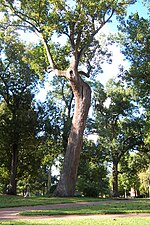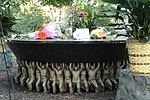Playmakers Theatre
Cultural infrastructure completed in 1850Historic district contributing properties in North CarolinaNRHP infobox with nocatNational Historic Landmarks in North CarolinaNational Register of Historic Places in Orange County, North Carolina ... and 5 more
Theatres in Chapel Hill, North CarolinaTheatres on the National Register of Historic Places in North CarolinaUniversity of North Carolina at Chapel Hill buildingsUniversity of North Carolina at Chapel Hill landmarksUse mdy dates from August 2023

The Playmakers Theatre, originally Smith Hall, is a historic academic building on the campus of the University of North Carolina at Chapel Hill. Built in 1850, it was designated a National Historic Landmark for its architecture, as an important example of Greek Revival architecture by Alexander Jackson Davis. It is now a secondary venue of the performing company, which is principally located at the Paul Green Theatre in the Joan H. Gillings Center for Dramatic Art.
Excerpt from the Wikipedia article Playmakers Theatre (License: CC BY-SA 3.0, Authors, Images).Playmakers Theatre
East Cameron Avenue,
Geographical coordinates (GPS) Address Nearby Places Show on map
Geographical coordinates (GPS)
| Latitude | Longitude |
|---|---|
| N 35.911944444444 ° | E -79.050555555556 ° |
Address
East Cameron Avenue 202
27514
North Carolina, United States
Open on Google Maps










